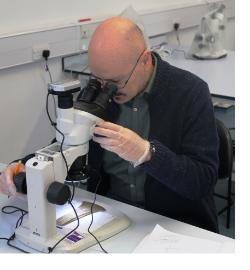TEMPI
 The project intends to reassess the chronology and classification of early Italian metalwork from the Late Neolithic to the initial early Bronze Age (c.4500-2000 BC). In particular, it aims at: a) proposing a new temporal sequence for early copper-alloy axes, daggers and halberds, which draws on a comprehensive set of radiocarbon dates; b) developing a new reflexive approach to metalwork classification, in which the technological transformations of the objects (including those determined by use-wear) is charted by scientific analysis. The underlying motivator of the project is to overcome idealistic and evolutionary assumptions on technological developments which led to an orthodox view whereby Italian metallurgy would have arisen significantly later than in other areas of southern and central Europe. In contrast, radiocarbon has shown that metal technology appeared in the Italian peninsula significantly earlier than previously thought, between the 5th and 4th millennia BC, and may have developed following a complex, non-linear trajectory.
The project intends to reassess the chronology and classification of early Italian metalwork from the Late Neolithic to the initial early Bronze Age (c.4500-2000 BC). In particular, it aims at: a) proposing a new temporal sequence for early copper-alloy axes, daggers and halberds, which draws on a comprehensive set of radiocarbon dates; b) developing a new reflexive approach to metalwork classification, in which the technological transformations of the objects (including those determined by use-wear) is charted by scientific analysis. The underlying motivator of the project is to overcome idealistic and evolutionary assumptions on technological developments which led to an orthodox view whereby Italian metallurgy would have arisen significantly later than in other areas of southern and central Europe. In contrast, radiocarbon has shown that metal technology appeared in the Italian peninsula significantly earlier than previously thought, between the 5th and 4th millennia BC, and may have developed following a complex, non-linear trajectory.
Alongside a collection and reassessment of all radiocarbon dates available for Italian metal-working and metal-using sites from c.4500-2000 BC, new radiocarbon dates will be taken from Copper Age metal-rich contexts, especially single inhumation burials. In addition, a reassessment of all typological cross-links with other areas of Europe, particularly significant in the case of Northern Alps and Central Europe, will be undertaken.
New classification criteria of metal artefacts will be grounded on the macro- and microscopic analysis (‘use-wear’ analysis) of a large sample including dozens of Italian copper axes, daggers and halberds stored in various museums in Italy and UK. Indeed, scientific analyses (metallography etc.) have shown that early metals (especially axes) were often modified during their life-cycles by forging, use and re-sharpening. This problem was not taken into account in early typological studies, which treated metal objects as fixed and immutable. Therefore, the degree to which these alterations may affect our capacity to classify the objects needs a re-assessment. In order to test the accuracy of this microscopy-enhanced observation, a Neutron Diffraction analysis of a sample of Italian artefacts held by the British Museum (London) – previously subject to optical examinations - will be carried out. ND is a complex but non-destructive analytical method that can unlock the technological history of metal objects from casting to deposition. The analysis, which concentrates on axes, will be conducted at ISIS Facility (Didcot, Oxfordshire).
Next step of the TEMPI project will be to develop a new way to classify copper-based artefacts. Significant morphometric variables (e.g. length, width at cutting edge, side curvature, etc.) will be measured for all the objects whose drawings are of sufficient quality. At the same time all variables based on the degree of life-cycle alteration shown by use-wear and ND will be assessed, and random, non-typological, variables will be discarded, until culturally meaningful groups of objects (or ‘types’) are arrived at. The final result, including as an integral part radiocarbon dating and contexts sequencing, will be an attempt to assess chronological position and duration of each object type, and the technological evolution of metal-working and metal-using in Italy in the timespan 4500-2000 BC.
Researcher: Dr Cristiano Iaia, Marie Skłodowska-Curie fellow
Supervisors: Dr Andrea Dolfini, School of History, Classics and Archaeology, University of Newcastle upon Tyne (UK); Dr Winfried Kockelmann, ISIS Facility, Didcot (UK)
Sponsors: European Commission, Horizon 2020
Partners: Science and Technology Facilities Council, STFC.
Collaborations: Soprintendenza Archeologia dell’Emilia Romagna; Soprintendenza Archeologia della Toscana; Museo Preistorico Etnografico “Luigi Pigorini”, Roma; Musei Civici di Reggio Emilia.
